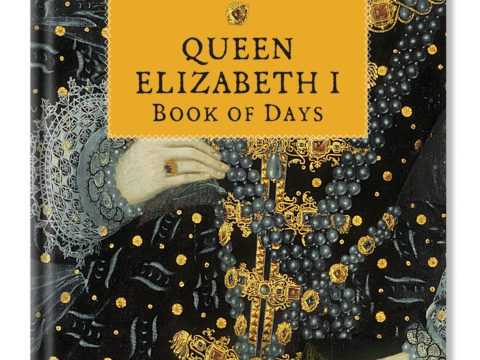Elizabeth I: Life Story
Chapter 23 : Gloriana
Whilst her fleet was pursuing the Spanish, Elizabeth herself travelled to Tilbury, to review her troops, and it is here that she may have delivered the most famous speech of her life. Although some of her councillors had been nervous about the idea of her exposing herself to the risks of assassination, Leicester was perfectly sure that she would be safe, and, as almost always, she listened to him. As Elizabeth’s biographer, Lisa Hilton, points out, there is no contemporary record of the armoured breastplate she is later described as wearing, nor the rousing speech that assured her people that she had ‘the heart and stomach of a king’. The oration generally ascribed to her does not appear in the recognised form until 1623.
Hilton notes that the first record of a speech is from a wall-painting at St Faith’s Church, Gaywood, Norfolk, dated 1588, and apparently taken from the testimony of an eye (or ear)-witness, although the words were not published until 1612. It reads:
I have been your prince in peace, so will I be in war, neither will I bid you go and fight, but come and let us fight the battle of the Lord. The enemy may challenge my sex for that I am a woman, so may I likewise charge their mould, for they are but men.
As soon as Elizabeth heard of the success of her fleet, and understood that the immediate danger was over, she dismissed most of her soldiers and sailors. Although her councillors and her sea-captains protested, funds were so short that she had little alternative. She had already been obliged to borrow, any surpluses she had built up through careful management of her income had been swallowed up, and the subsidies granted by parliament were easier to speak of than to count.
On 24th November 1588 a public thanksgiving was held at St Paul’s Cathedral, where the multitude cheered the queen in a public outpouring of love and gratitude for their queen’s and their own, safety. For Elizabeth, however, the victory was marred by the death of Leicester, her ‘Sweet Robin’, who had left Tilbury for Buxton, in the hope that the spa waters would restore his health. He had died en route. She kept his last letter to her at her bedside for the rest of her life.
The war with Spain ground on until the end of Elizabeth’s reign, with Philip sending out more armadas, none of which made any significant impact, but in retrospect, the summer of 1588 was the high-water mark of Elizabeth’s rule. Her image as Gloriana, defeating the enemy and safeguarding Protestant England was forever enshrined in the memory of the English. Depictions of the queen became ever more elaborate – the Virgin Queen being almost elided in the minds of her subjects with the Virgin Mary.
Although no man could ever equal Leicester in Elizabeth’s affections, she was surrounded by a new generation amongst whom two stood out – Walter Raleigh, a relative of her former governess and friend Katherine Astley (neé Champernowne) and, most loved and indulged of all, Robert Devereux, 2nd Earl of Essex.
Essex was the son of Walter Devereux, Viscount Hereford, cousin to the queen several times over, who had been a staunch supporter during the Rising of the Northern Earls, and had been promoted to the earldom of Essex in consequence. This first earl of Essex had been Deputy Lieutenant of Ireland – a post he carried out with the increasing brutality that marked Elizabethan policy in that land.
Whilst England had, for many centuries, sought to subdue Ireland, there had grown up an Anglo-Irish aristocracy which was loyal to the Crown, and had held the native Irish, under their traditional chieftains, down. With the Reformation, the Anglo-Irish were split and, as the Irish held fast to Catholicism, when England became avowedly Protestant, the Irish were not just seen as a nation to conquer, but as inferior beings. A succession of lieutenants had treated the population with increasing brutality, and many of Elizabeth’s courtiers thought that wholesale plantation of Protestants into Ireland, with the commensurate confiscation of land from Catholics was the solution.
The first earl of Essex died whilst on duty in Ireland, and his widow, the queen’s cousin, Lettice Knollys, married the Earl of Leicester – much to Elizabeth’s fury. Essex’ and Lettice’s son, Robert, became second earl of Essex, and despite her rancour against Lettice, since the young Essex was beloved of his step-father, Elizabeth welcomed him to her court – and was soon enchanted by him.
More on the relationship between the two can be learnt in this Guest Article by Sarah Gristwood.
